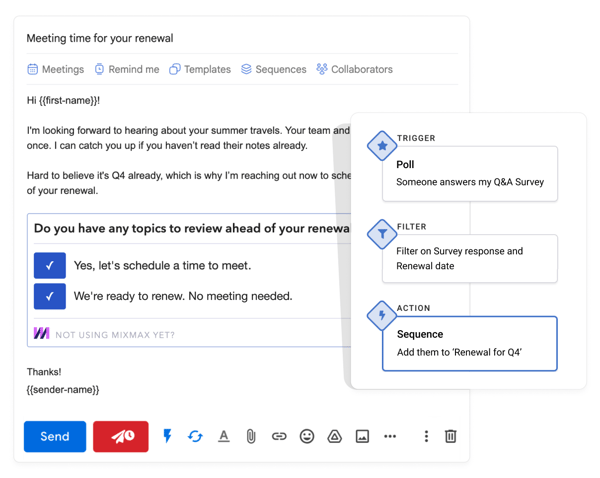
We’ve all been on the customer-end of a contract coming up on renewal. How frustrating is it to be blind sided by an auto-renewal you didn’t get to cancel in time?
Surprises can be fun – like birthdays or celebratory milestones – but not when it comes to renewals for your customers.
The cost of acquiring a new customer is over five times more than keeping an existing one, which is why your renewal strategy should be cohesive and weaved into the entire customer experience from Day 1.

Customer success and account managers play a crucial role in properly preparing customers for the renewal conversation. When customers feel like they’ve been left in the dark, their expectations may not have been aligned with yours.
Luckily there are some easy steps to take right now that’ll set you up for a strong renewal conversation and improve your customer experience along the way.
Avoid surprises and delight your customers. Mixmax automates repetitive or manual tasks to help you stay on top of it all throughout the renewal process. Try Mixmax for free.
Every customer’s needs are unique, and their experience with your brand will vary. While you want every customer to be successful, it’s important to establish a consistent internal process.
Plan milestones to recap how the engagement is going, depending on the length of your contract.
Determine three important moments in which to reach out and communicate with customers about what you’ve accomplished, what the results showed, what the future plan is and how you’ll execute it.

Perhaps you reach out on a 30, 60 and 90-day schedule, each touch point building on the next. By the 90-day mark, both you and the customer should be aligned in experience and future actions, and it should be clear when the formal renewal conversation is happening.
Not only will your customers be prepared for the renewal meeting, but the topics and deliverables in the next agreement should have already been discussed, too. It’s an extension of your previous conversations, rather than an ambush or forced upsell conversation.
An example of a 30-day checkpoint email might look like this:
“Hi ,
Can you believe how quickly our first month together has gone by? In such a short time, we’ve been able to achieve so many initiatives:
deliverable 1 / result
deliverable 2 / result
deliverable 3 / result
What do you think has been most valuable to you so far? Any area you feel like we’re missing the mark?
Based on where we stand, here’s where we should focus our efforts to see the most value over the next 30 days:
initiative 1
initiative 2
When do you have time to connect about the execution plan and timeline for these projects? I’d love to hear your feedback and make sure we continue the success for the next 90 days we have together.
Kind regards,”
Plan your checkpoints around what’s best for your business and renewal cycle. You can schedule a final reminder, 30 or 15 days before the contract ends, and spread out the checkpoints back up to their initial onboarding.
Avoid the surprise factor when it comes to renewal plans. They’re just as busy as you are, and they need reminders. Your customers need ample time to reflect and evaluate internally.
The more consistent ammo you provide them the better, and checkpoint emails are a strong reference for them to visit as they decide to sign on with you again or not.
While checkpoint emails are strong references for both you and your customers, they shouldn’t be an added stress to anyone’s workload.
Customer success teams are leveraging the best sales tools to create follow up email templates and an automated email schedule in which they’re sent.
It’s tough to stay caught up with every customer account status when they’re all at different points in their journey. To prevent any important checkpoints from being forgotten, pre-schedule them on the days you’ve determined are best.
Leverage an email automation tool or scheduling software to prepare delivery dates (and their notifications) as soon as a new customer signs on.

To make things simple, you can create templates for each of the emails, leaving your customer success or account manager with a small amount of personalization to be done, specific to the customer experience and results.
For example, customers are scheduled to receive Checkpoint Email 1 after 30 days from sign-on. After 60 days, customers are scheduled to receive Checkpoint Email 2, and it continues based on the length of your agreements.
While customer results vary and not every experience goes as planned, this communication is generated from a consistent foundation (templates). Just as an outbound sales email can include portions of customization, these checkpoint emails are formatted similarly for your Customer Success reps.
Just as an outbound sales strategy includes a call to action for your prospects, it’s important to make next steps crystal clear for your customers too. We all just want to know what the plan is and how to get there.
When crafting your checkpoint email templates, determine exactly what the next steps are for the time leading to the next checkpoint, or plan a time to discuss it together.
Pave a clear path so your customers can trust you and have confidence in your plan to turn challenging moments around, as well as magnify the successes they’ve seen.
Oftentimes customers partner with you to manage or handle something they were hoping to solve or offload, so it’s important to communicate often and clearly to remind them of just that.
.gif?width=318&name=giphy%20(5).gif)
Take care of the minute details and process steps to build confidence in your overall ability to achieve success. The easier you communicate, the smoother the customer experience, the more likely they are to renew.
When sending checkpoint emails, it’s a great opportunity to gather customer feedback.
As you recap consistently, you set yourself up to highlight wins, celebrate milestones, uncover new avenues of opportunity and gather feedback at those crucial times throughout your engagement.
Whether it’s a survey, an open-text questions or a rating scale, this is a great method to consistently gather feedback, rather than waiting to hear about their experience at the end of the agreement.
This feedback could dictate what happens next, or if you need to pivot or provide more support for specific customers. It could create an opportunity to strengthen the customer experience or even save a relationship before it’s too late.
.gif?width=382&name=giphy%20(3).gif)
Planning and scheduling checkpoints from Day 1 can eliminate confusion when it’s time to have the renewal conversation. Prepare your customers and yourself, and begin to plant the seeds of the conversation throughout the course of the engagement.
Save yourself time by preparing follow up email templates and email delivery ahead of time. Don’t surprise your customers with a renewal plan they haven’t already considered or previously discussed with you — Save the surprise for your incredible results!
At the end of the day it’s about giving your customers the best experience possible. Implementing applications that deliver operational excellence sets you on the right path.
Sign up for a Mixmax demo and see how a curated communication experience combined with workflow automation makes it easy for your customers to do business with you.
.png?width=450&height=250&name=Episode%20Graphic%20(1).png)
